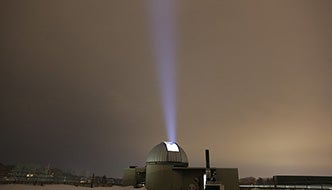
The moon is projected upon EMPAC’s large façade as part of Italian artist Rose Barba’s installation The Color Out of Space.
“We see the universe in a very funny way,” Rensselaer physicist Heidi Newberg says. Her voice is broadcast from a small projection house across 8th Street from the Curtis R. Priem Experimental Media and Performing Arts Center (EMPAC) and might as well be describing the line of spectators bundled up on a chilly March evening, staring up at the moon projected upon the building’s large façade. The high-definition photograph gently flickers before the image fades and a spiral nebula comes into focus, accompanied by the voice of adjunct physics professor Matthew Newby on the film’s sound track.
The Color Out of Space is an EMPAC-commissioned project by Italian artist Rosa Barba, developed in collaboration with Rensselaer’s Hirsch Observatory, professor of physics, applied physics, and astronomy Heidi Newberg, and astronomy students Nicholas Palmieri and Jake Weiss. Exploring “the speculative intersection of astronomy and art,” the two-part installation is constructed to visually connect the two buildings across campus, highlighting the common ways in which artists and physicists start with facts before “speculating” into the unknown.

Physics students Nicholas Palmieri and Jake Weiss take images of the moon through the Boller & Chivens telescope at the Hirsch Observatory.
The theme is echoed with White Museum, the project’s sister installation inside the dome of the Hirsch Observatory, located on the roof of the Jonsson-Rowland Science Center. Beside the observatory’s 16-inch Boller & Chivens telescope with its sensitivity to far-off celestial light, Barba has installed a 70 mm projector to fire a powerful white beam of light into the sky for poetic juxtaposition. The two pieces will be on view every Saturday through the end of March, with White Museum opening at 7 and The Color Out of Space screening at 8.
Invited by EMPAC curator of time-based visual arts Victoria Brooks, Barba first came to Rensselaer in January of 2014, while she was in the country installing a show at MASS MoCA in nearby North Adams, Massachusetts. Known for her work in site-specific film art, Barba was commissioned by Brooks to create a unique piece for the architecture of EMPAC. “I’m always interested in finding a subject in the places where I work and creating a narrative to come along with that,” says Barba. This is the beginning of the artist’s process of “speculation.” The Hirsch Observatory provided Barba with her subject.
Barba and Brooks met with Newberg to discuss collaborative possibilities and, in the summer of 2014, Palmieri and Weiss were selected to help. With the purchase of a new CCD astronomy camera for use with the telescope, Palmieri and Weiss began capturing images of distant planets and galaxies. The two communicated with Barba, who is based in Berlin, via email, and Barba began the painstaking process of editing the images into her eventual 35-minute film The Color Out of Space.
For the film’s sound track, Barba interviewed Newberg, Newby, astronomer Jean-Pierre Luminet, and recorded readings of monologues and poems (William Blake’s “The Tiger”), which were eventually collaged by her husband Jan St. Werner. St. Werner’s celebrated electronic duo Mouse on Mars performed at the project’s opening night on March 7 in EMPAC’s Studio 1.
Prior to the show’s opening, Barba and Newberg presented a talk on March 3 in order to describe the similarities between their respective fields. Newberg described astronomy as a fundamentally observational (as opposed to experimental) science, in the sense that astronomers concern themselves always with discovering what already exists but is not yet known. It’s this form of scientific speculation—from established facts into the uncharted—that runs parallel to that of Barba’s artwork. And, like artists, astronomers must make aesthetic decisions about how to present their findings. At some point in the process, Newberg said, all the data one collects must encounter the human senses to be shaped into meaning.

Rosa Barba’s White Museum at the Hirsch Observatory projects a powerful white beam of light into space as part of The Color Out of Space.
In a way, Barba works in the opposite direction, starting with the qualitative human perception of a concept like “deep” astronomical time and then following it into what can be known about the subject through science.
In each case, the process of observation and speculation proceeds at nature’s mercy. An especially wet summer made it difficult for Palmieri and Weiss to capture the images Barba needed, and the two worked well into the winter waiting for clear nights when particular bodies like Jupiter came into view. Up until close to the end, Barba didn’t fully know what material she’d be working with, an ambiguity that drove the creative process and allowed the students to collect a sizable archive of images that will be used reciprocally for study in the astronomy curricula.
For both the artist and the astronomer, The Color Out of Space is a unique way of seeing the universe—equally so for the pedestrian strolling by EMPAC on a Saturday night this month, or for a motorist viewing the show as far away as on Interstate 787. In all of these cases, the first glimpse is the element that draws the attention in and begins the process of thinking, dreaming, speculating.
More information on the project, including show times and viewing instructions.


